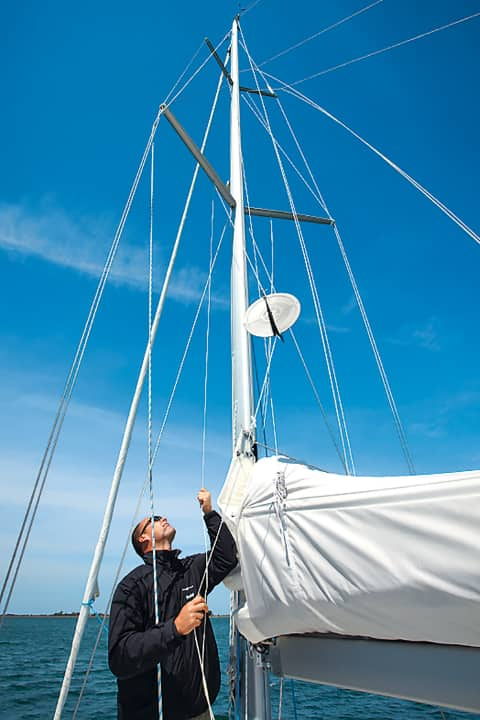Anchor special: Better anchoring, episode 1: Chain or line, how long?
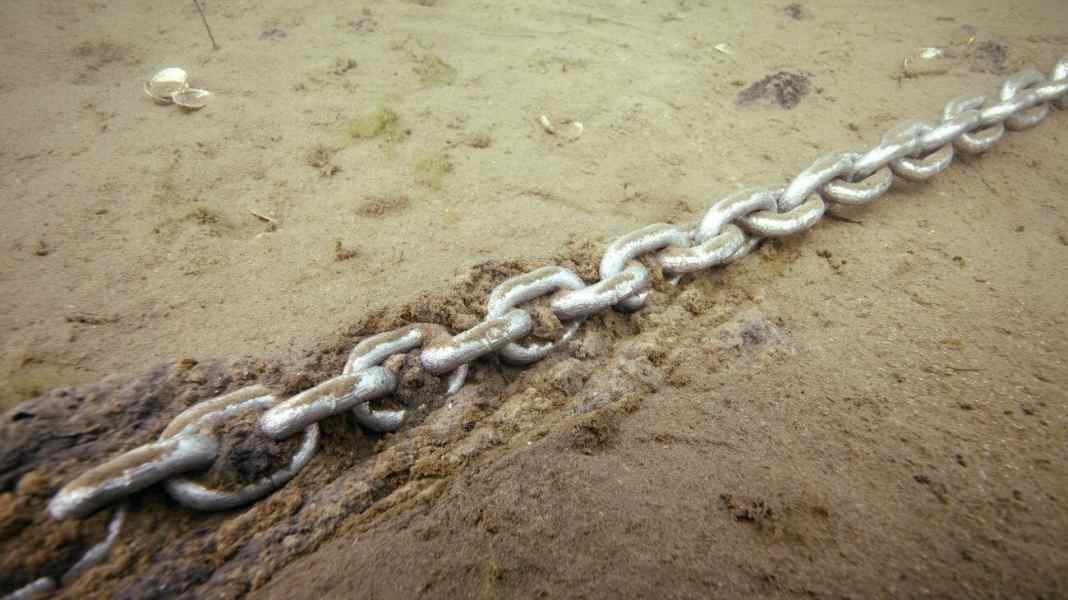
In this special:
- Better anchoring, episode 1: Chain or line, how long?
- Better anchoring, episode 2: 6 tips for the ideal anchorage
- Better anchoring, episode 3: safely run in the ground bar - 9 Manoeuvre
Anchoring in our waters is as attractive as ever. Silence reigns in a sheltered, ideally deserted bay. All you can hear is the whisper of the wind and the gentle lapping of the waves against the hull. The impressive light conditions at sunset and sunrise are often added to the mix. For many, these moments are what make sailing so precious.
The right equipment is essential for a relaxed overnight stay at your own anchor. Opinions differ when it comes to the choice of anchor: some opt for the inexpensive plate anchor, others prefer the ploughshare anchor in the style of a CQR, and still others are firmly convinced that only the spade shape of the stirrup anchor offers reliable hold.
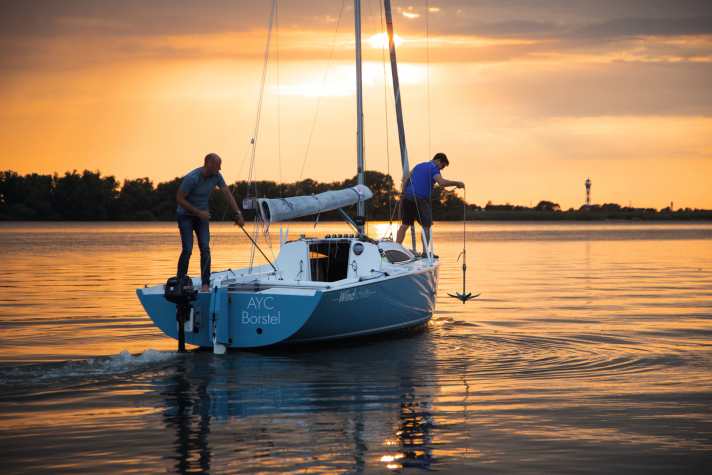
There is no absolute answer to the question of the ideal ground anchor, as different design features can be advantageous depending on the nature of the seabed. There is no such thing as a universally applicable anchor. However, our comprehensive tests over the last 16 years with 27 different types clearly show which features characterise a good design and which should be avoided.
The size of the anchor, which is usually determined by its weight, is a key criterion. The recommendations of manufacturers or classification societies such as DNV GL, which are graded according to ship displacement, are merely approximate values. As a general rule, the choice of a lighter anchor entails a loss of safety. If you are unsure, it is advisable to opt for a higher weight class.
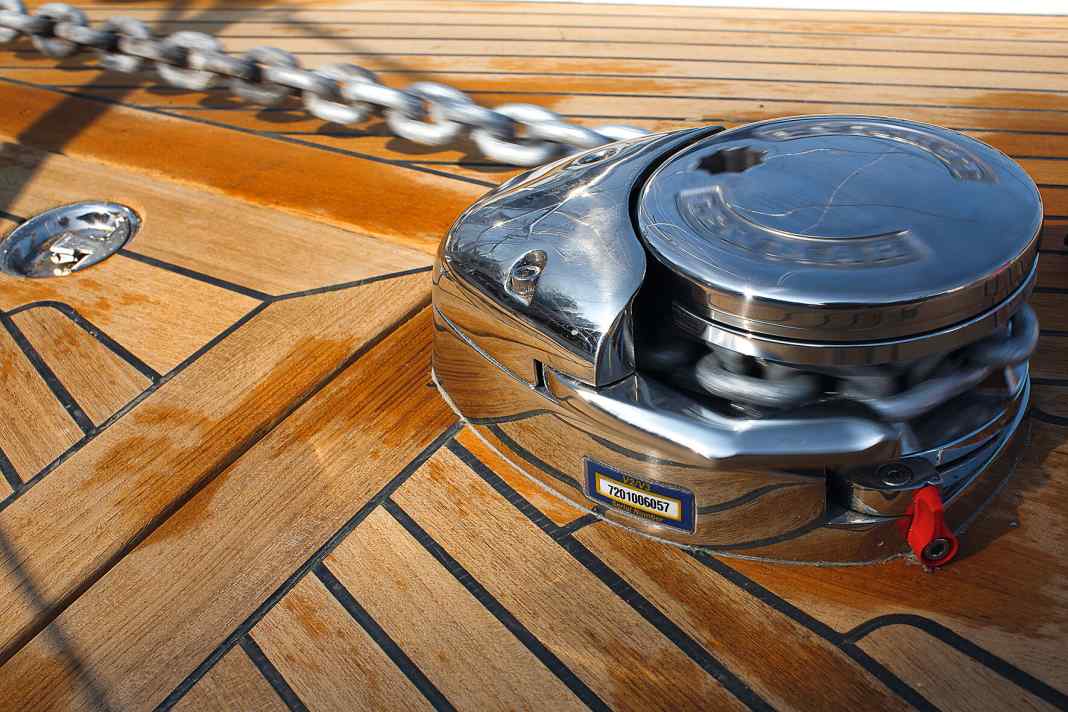





This applies in particular to the second anchor. A lighter version is often recommended, but this is incomprehensible. It should not only complement the main harness, but also be able to replace it in the event of failure or loss. Consequently, the same criteria should be applied when selecting it.
Anchor types in comparison
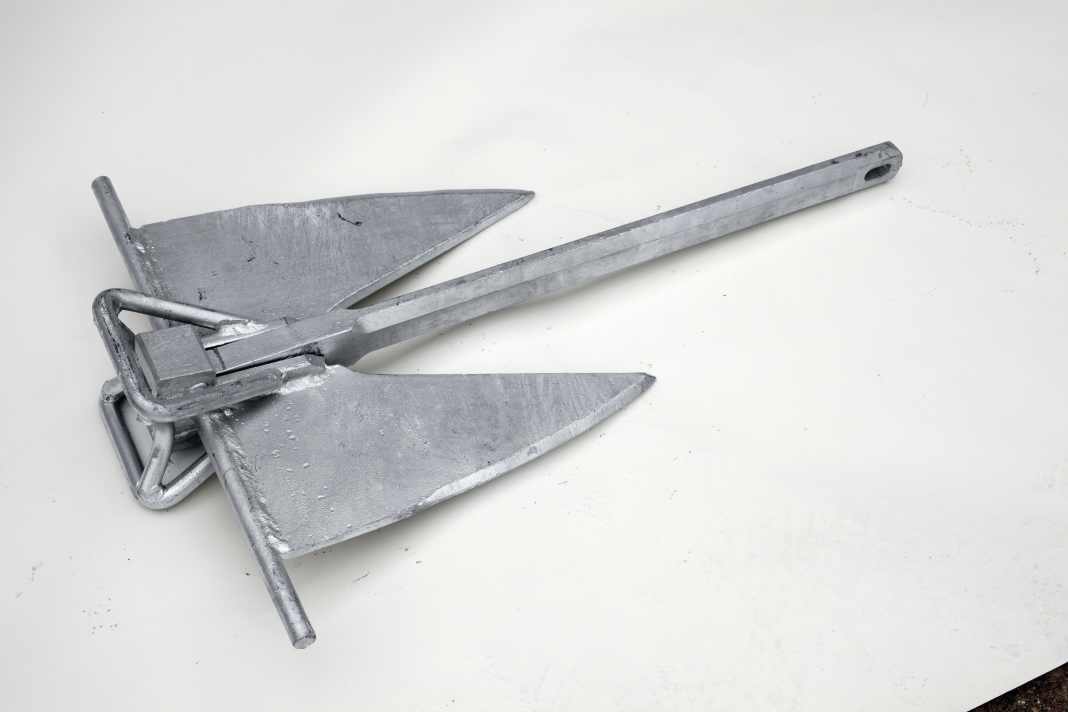



Advantages Inexpensive, easy to stow in the back box, usually grips well on sand
Disadvantages The biggest problem is the lack of self-stabilisation of the structure. If the anchor starts to move in the ground, it is usually as good as broken out. Even small irregularities in the ground conditions or a changing angle of pull can cause the anchor to tip on its side, a fluke then protrudes from the ground and sooner or later the anchor breaks free
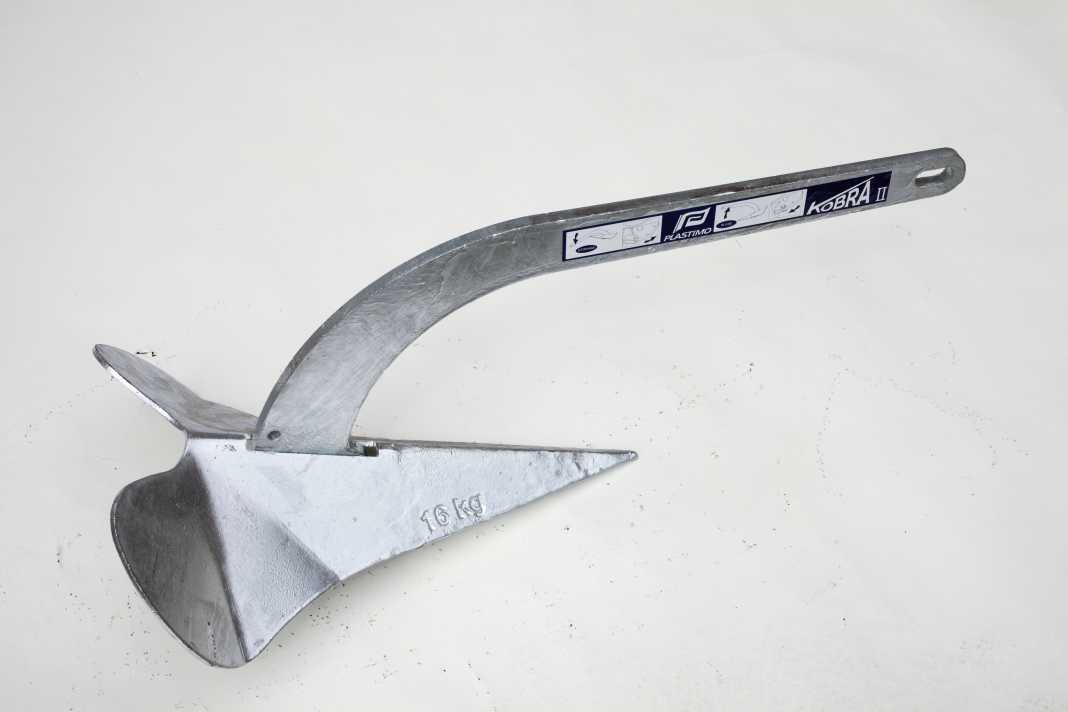



Advantages Easy to drive in the bow roll. The plough shape automatically straightens the anchor and stabilises it. The Cobra model from Plastimo was particularly convincing in the tests. It usually grabs hold as soon as it touches the ground and digs in very well. The anchor also sits very stably in the ground and is comparatively inexpensive
Disadvantages Various models on the market, not all work equally well. Versions with a joint are less recommendable
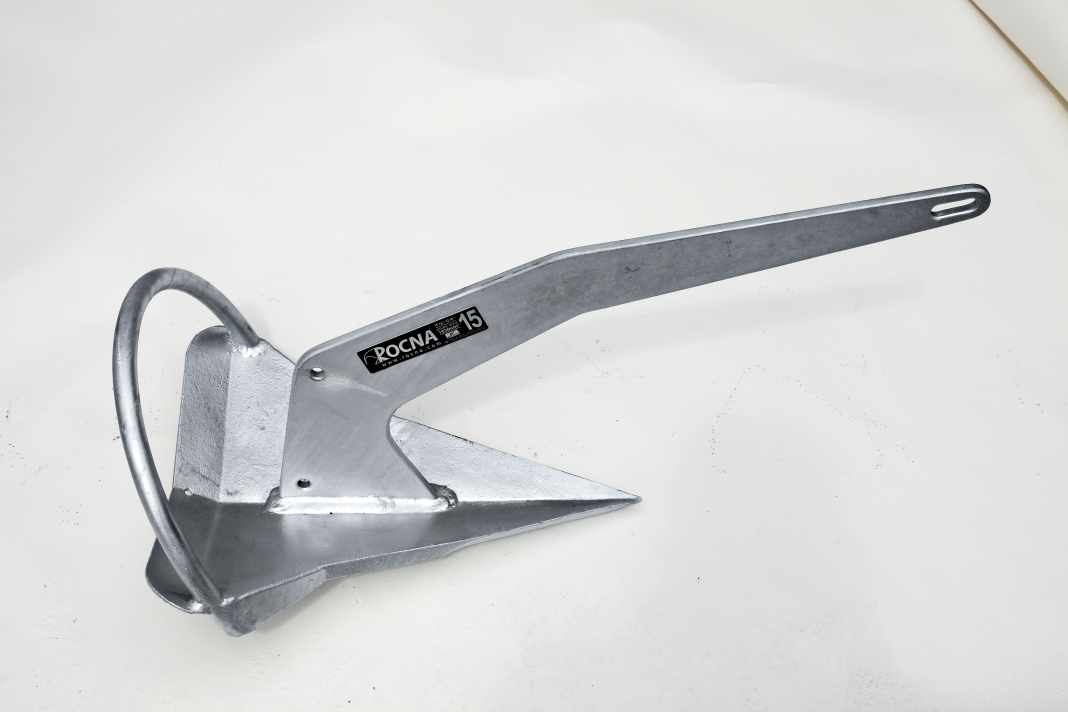




Advantages Fits well into most bow fittings. Shape stabilises at the base, depending on the design, a bracket or the weight distribution helps to straighten. The tip usually fits well. Models with a bracket can be carried very well on it
Disadvantages There are many models on the market, some of which exhibit very different behaviour despite barely visible differences. Some models are only convincing on sandy ground
Maths instead of textbooks
Even the best anchor is of little use if the connection to the boat is not right. Above all, the length of the attached chain or line is crucial for the safe functioning of the anchor. Only if the anchor shank remains on the ground under load can the iron develop its full holding power.
Traditionally, the chain length is specified as a multiple of the water depth. As a rule, the recommendation is to use between three and five times as much chain as the depth sounder indicates. For ropes, eight times the water depth should be fished.
The range of the recommendation alone casts doubt on its correctness; moreover, contrary to all practical experience, the wind force is not taken into account.
That's what YACHT reader René Lattmann thought. The experienced skipper from the Cruising Club of Switzerland took advantage of the corona-related time off sailing to study the underlying maths. In the static case, i.e. when waves and swell are neglected, the course of the anchor chain or line follows the so-called chain line, which can be calculated with the help of hyperbolic functions.

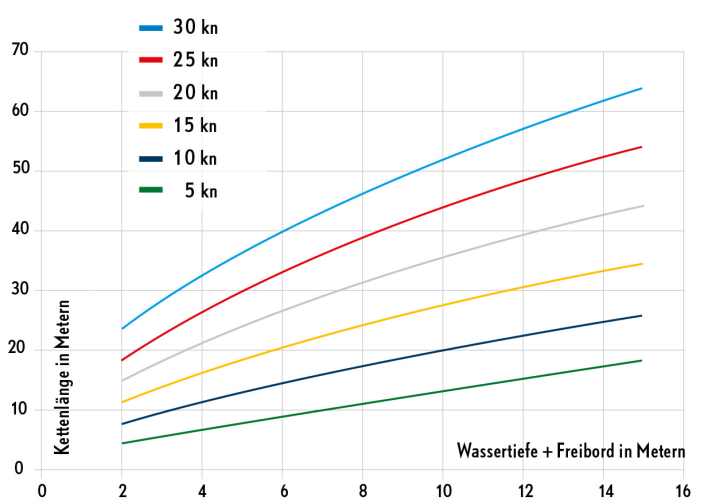
The exact course results from the difference in height between the anchor and the bow, the pull and the chain weight per metre. This also makes it possible to calculate the length required to ensure that the anchor shank is not lifted.
The exact derivation and solution of the equations would go beyond the scope of this article, but is not necessary to understand the results. It is sufficient to consider a simplified approximation. Assuming that the wind speed is significantly greater than the water depth, the following formula for the minimum chain length in metres is obtained:

Where "depth" is the sum of the water depth and the freeboard and the wind in knots. "K" is a ship and chain-specific constant:
A" stands for the yacht's area exposed to the wind in square metres, "w" is the chain weight per metre in the water. The area of attack must be estimated. For the practical calculations, Lattmann used the information from Joachim Schult's book "Richtig ankern" (Anchoring correctly) and adapted it for a Hallberg-Rassy 340.

Another option is to measure the chain pull directly at different wind forces. However, due to the expected forces of several hundred decanewtons, this requires a massive tension scale.
Simulated anchoring
With the help of a programme written by Lattmann, different anchor scenarios can be run through. For example, the course of a chain according to the five-fold rule and what length is actually required. It is striking that the rigid coupling to depth fails both in shallow water and at great depths. With two metres of water and one metre of freeboard, this results in a chain length of 15 metres. Even the pull generated by 15 knots of wind lifts this chain so strongly that the anchor shaft is pulled upwards with two decanewtons, which is roughly equivalent to the weight of two kilograms. With a little more wind, the configuration would definitely be overstretched, so more than five times the length is required in shallow water.
The opposite is true at deeper depths. According to the rule of five, 40 metres of chain should be set at eight metres. In reality, however, at 15 knots of wind, around 28 metres would be enough to keep the angle of attack of the chain on the anchor to zero.
The stronger the wind, the more the mismatch of the rule of five shifts to greater depths. If the wind picks up to 6 Beaufort, the rule states that a sufficient chain length can only be achieved from a water depth of ten metres.
In the calculations, it is important to note that an anchor shaft lying flat on the ground is required, which undoubtedly provides the maximum holding force of the anchor. It is difficult to predict how much the holding capacity will be reduced by a slightly upward tensile angle.
If the chain is allowed to rise slightly, the possible anchor depths increase. This consideration is the origin of the simple chain length rules. They are based on the hope that a fully tensioned chain with a pitch of 1:5 or 1:8 will not lead to the breakage of the base iron.
Chain or lead?
The programme can also be used to simulate different chain/line combinations or lead anchor lines. The chain is clearly superior, whereas the differences between the chain lead and the lead line are comparatively small. With the 40 metre long ballast line, it is just possible to anchor at a water depth of four metres in 20 knots of wind. With ropes and ten metres of chain leader, the maximum depth increases to six metres. A pure chain would be sufficient for a water depth of almost ten metres, but at 56 kilograms it also weighs three times as much as the chain/rope combination and around nine times as much as the lead line.
A word about the chain: The material and design are not important for the calculation - but they are in practice. If you want to be on the safe side, use a galvanised and calibrated version. The breaking load should be guaranteed. There are also chains in circulation that can only withstand a fraction of the usual forces. Stainless steel chains are not only much more expensive, they are also susceptible to corrosion. The problems usually occur at the weld seams and are not always easy to recognise, so only branded goods should be used. The biggest advantages of stainless steel chain are It takes up less space in the anchor locker, its smooth surface allows it to glide better, and it does not form a large pile under the winch.
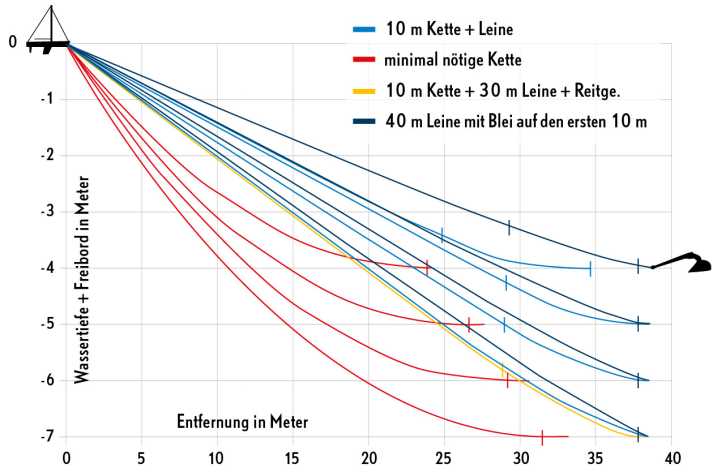
The effect of a riding weight is also interesting. The effective chain length can be increased and an overloaded harness can be stabilised by placing a weight close to the anchor, for example a second anchor.
The effect depends on the mass of the riding weight relative to the chain. The heavier the weight, the better. In our example, with a weight weighing 13 kilograms in the water and an eight millimetre thick chain, the effective length can be increased by around eight metres or the wind range can be increased from 20 to 25 knots.
The limits of the model
Due to the influence of the wind attack area and the chain, these values, just like the other diagrams, only apply to a Hallberg-Rassy 340 or comparable yachts equipped with an 8-point chain. The assumed effective windage area of the hull and rig is around 13 square metres. Larger yachts also need more chain, while more wind-slippery boats can manage with less.
In addition, the calculations refer to stationary anchoring. In practice, however, the yacht will move as the wind increases; it will begin to sail back and forth at the anchor. Depending on the type of boat and wind force, considerable speeds can be reached before the chain becomes stiff and the movement stops. At this moment, the kinetic energy is transferred to the anchor and higher tensile forces occur. The situation is similar with swell, where the harness also has to withstand additional loads.
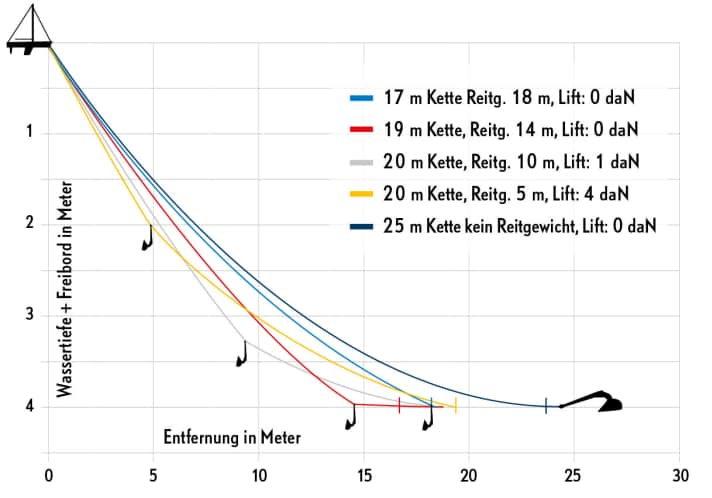
The individual chain links have no stretch, so such load peaks can only be cushioned by lifting the chain and reducing the chain slack. However, this is only possible to a very limited extent in shallow water, as there is not enough chain weight. A chain-rope combination is then very advantageous. Mooring ropes can absorb a comparatively large amount of energy due to their elongation behaviour of 5 to 15 percent (see test in YACHT 13/2010). As a result, it absorbs the impact of the swaying well. In addition, it can be countered with an anchor sail. In our practical tests, it was possible to reduce the angle of the sway at 6 Beaufort by around 25 degrees, which significantly mitigated the jerking into the chain.
Even if the estimation of the effective wind attack area and the dynamic behaviour entail uncertainties, one thing is clearly confirmed by the theoretical considerations and the example calculation: the fixed textbook factor does not result in the optimum chain length.
In local waters, the shallow water area is likely to be particularly decisive. Even in moderate winds, more than five times the water depth should be used. But the behaviour of the chain at greater depths is also interesting. Because deeper water does not automatically mean that an endless amount of chain is required.
Shallow water risk
When the yacht is at anchor, the harness must be able to withstand considerably higher loads than previously calculated. This can significantly increase the minimum chain length required.
The calculations carried out above to determine the minimum chain length required have already shown that not only the water depth but also the wind pressure plays a decisive role and that a simple multiple of the water depth can be dangerous.

To simplify the maths, we restricted ourselves to a stationary situation, i.e. only the forces generated directly by the wind were taken into account.
Long-distance sailor and YACHT reader Dr Mathias Wagner has made the same considerations, but has also looked at the forces caused by swell or swell and their consequences.
In addition to the static wind pressure, the kinetic energy of the boat is also considered, as it must be absorbed by the anchor gear. The energy depends on the displacement of the yacht and its speed and can be determined using the following formula:

Where "M" is the displacement of the yacht and "v" is the speed achieved by the swaying. The additional load on the anchor gear therefore increases with the displacement. The speed of the swaying has an even greater influence as it is squared. It can be estimated with the help of the log. If you look at the display in medium winds, you will realise: A few tenths of a knot are quickly reached.
We ignore the damping effect of any anchor stop for a moment; then the chain must absorb the energy of the swell. Since it has practically no stretch, this can only be done as potential energy by lifting the chain. Under the condition that the chain does not lift the anchor shank from the ground, the minimum required chain length can be determined from this. The detailed derivation of the formula can be found on the Website of the author The details are beyond the scope of this article.
We will therefore limit ourselves to the result for the chain length in metres:

The first term of the formula describes static anchoring, as already discussed in YACHT 12/2020. The second term approximately describes the effect of dynamic anchoring. "Y" is the water depth at the anchor including freeboard, "g" is the gravitational acceleration, "m" is the weight of the chain per metre in the water. "∆E" denotes the kinetic energy of the boat, which must correspond to the change in the potential energy of the chain. The parameter "a" summarises the influences of the weight of the chain, the area exposed to the wind and the wind force.
Risky shallow water
What the formula means in practice is best illustrated by an example. We will again assume a Hallberg-Rassy 340 with an 8-millimetre chain. By calculating the wind pressure differently, this time the wind attack area "Aeff" is 10 square metres.
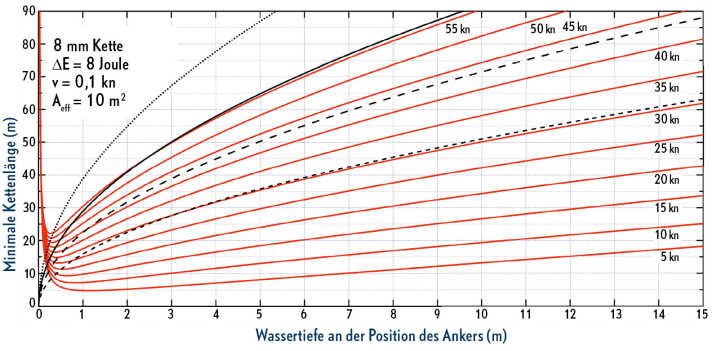
At a slewing speed of 0.1 knots, the chain has to absorb an additional energy of only 8 joules. This means that the load on the anchor corresponds to that of static anchoring over a wide range. In shallow water, the dynamic component becomes recognisable. The force acting on the anchor increases sharply.
The consequences for the chain length can be seen in the following diagrams. As long as little energy has to be absorbed, the dynamic effects only become apparent in water depths that cannot be reached due to the draught without digging into the mud with the keel.
It becomes critical when the chain has to absorb more energy because the boat is travelling at one knot, for example. As can be seen in the diagram below, dynamic anchoring becomes relevant in a large depth range. It is hardly possible to anchor at water depths of less than seven metres without overstraining the anchor.
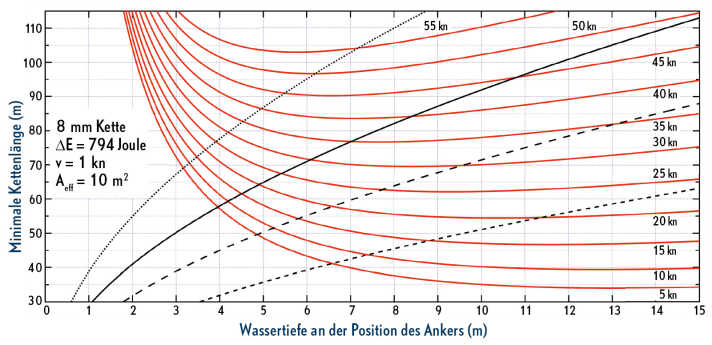
The black curves indicate the maximum load on the anchor. If, for example, no more than 500 decanewtons are to be expected, only chain lengths below this curve are permissible. This means that it may be necessary to move to greater anchor depths in order to reduce the load. Escaping into shallow water when there is a lot of wind and swell is not always the right way to go!
Long and thin or short and thick?
It is interesting to compare different chains. 80 metres of an eight-millimetre chain weighs as much as 35 metres of a twelve-millimetre version. The diagrams show the maximum depth possible for the chain length and wind force.
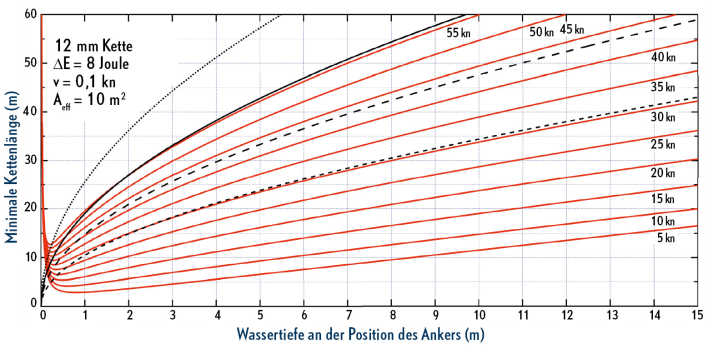
With 80 metres of stern chain, for example, it is possible to anchor at a depth of eleven metres in 45 knots of wind - with 35 metres of twelve-metre chain, on the other hand, it is only possible to anchor at a depth of up to five metres. As the distance to the bow roller has to be added to the water depth, there is hardly any room for tide-related water level fluctuations.
In areas with large water depths or strong tides, you are better off with a thin and long chain. If you want to keep the schwoi circle small because the bays are overcrowded, but tides and water depths do not play a major role, then a heavier and shorter chain is the better choice.
Whether the dynamic effects need to be taken into account depends on the conditions and the anchor depth. The shallower the water, the sooner the anchor chain reaches its limits. This once again emphasises how sensible it is to use a rope strop with a shock absorber to take the strain off the chain. The much greater elongation of the sling can absorb a large proportion of the energy.
